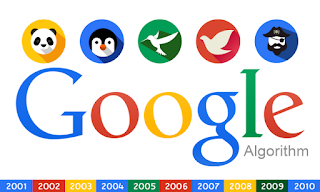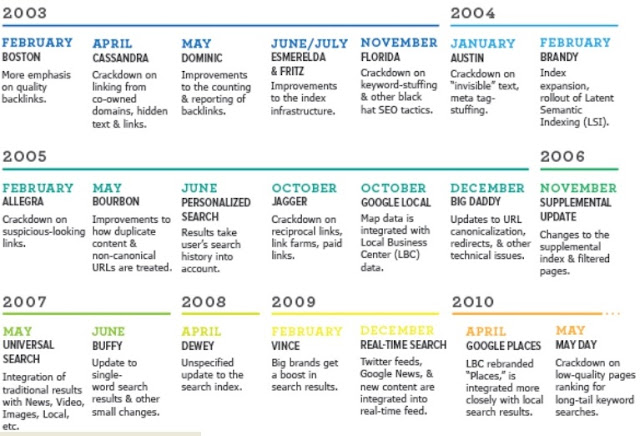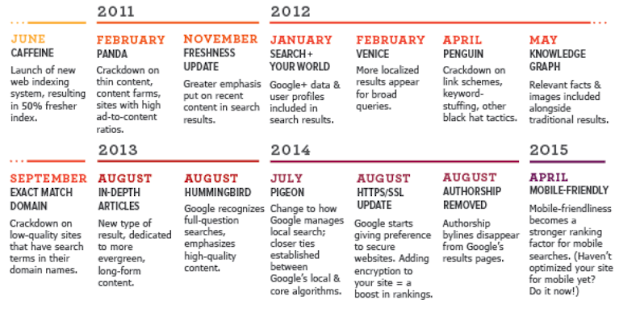Google Search Timeline
Search
Engine Optimization has a significant impact in the Digital Marketing space.
Google has over the years created a niche for itself in the search engine space
by completely overhauling the algorithm of how its search engine function works. This is a result of a well researched
algorithm and the constant attempt to rework the same to match current scenario.
Google has come out with some major releases over the years which is elaborated further in this post.
Google’s
take on the Google Algorithm Updates
is to ensure that spam and low-quality content does not surface in the search results.
Mentioned further is an overview of Google’s major algorithm updates and their
impact on the digital marketing landscape.
Niche Specific
Link Specific
Quality Links
SEO
Passing Juice
Google
AdWords
Google
Adsense
Social
Media Signal
Google
Penguin
Parked
Domain Updates
Google
Pigeon Update
2003 Updates
Cassandra Update in April was to tackle link-quality issues, such as humongous linking from co-owned domains. This update also ensured that hidden text and links are no more a parameter for optimization.s
Dominic Update in May ensured Google bots like "Freshbot" and "Deepcrawler" scoured the web, and many sites reported bounces. The way Google counted or reported backlinks seemed to change dramatically.
Florida Update in November was a death knell for low-value late 90s SEO tactics, like keyword stuffing
2004
Updates
Austin Update in January was Google's continued attempt to eliminate deceptive on-page tactics, including invisible text and META-tag stuffing.
Brandy Update in February includes a massive index expansion, Latent Semantic Indexing (LSI), increased attention to anchor text relevance, and the concept of link neighborhoods." LSI expanded Google's ability to understand synonyms and took keyword analysis to the next level.
Nofollow update in January was to stop spam and control outbound link quality. Google, Yahoo, and Microsoft collectively introduce the "nofollow" attribute. Nofollow helps clean up unvouched for links, including spammy blog comments.
Allegra update in February is when webmasters witnessed ranking changes.
Bourbon update in May announced that Google was rolling out changes in search quality. Bourbon changed how duplicate content and non-canonical (www vs. non-www) URLs were treated.
Personalized Search Update in June automatically personalized search results based on users search histories.
XML Sitemaps Update in June is when Google allowed webmasters to submit XML sitemaps via Webmaster Tools, bypassing traditional HTML sitemaps, and giving SEOs direct (albeit minor) influence over crawling and indexation.
The Jagger Update in October mostly targeted at low-quality links, including reciprocal links, link farms, and paid links.
Google Local/Maps Update in October Google merged its Maps data into the Local Business Center, in a move that would eventually drive a number of changes in local SEO.
Big Daddy Update in December is when Google handled URL canonicalization, redirects (301/302) and other technical
2006 Updates
Supplemental
Update — November 2006
Throughout 2006, Google seemed to make changes
to the supplemental index and how filtered pages were treated. They claimed in
late 2006 that supplemental was not a penalty (even if it sometimes felt that
way).
2007 Updates
Universal Search Google integrated traditional search results with News, Video, Images, Local, and other verticals, dramatically changing their format. The old 10-listing SERP was officially dead.
2008
Updates
Google Suggest Update in August resulted in a major change to their logo-and-a-box homepage Google introduced Suggest, displaying suggested searches in a drop down below the search box as visitors typed their queries.
2009
Updates
Real-time Search in December is real-time search for Twitter feeds, Google News, newly indexed content, and a number of other sources were integrated into a real-time feed on some SERPs. Sources continued to expand over time, including social media.
2010
Updates
Google Places Update in April is the official launch of Google Places re-branded the Local Business Center, integrated Places pages more closely with local search results, and added a number of features that included local advertising options.
May Day Update in May confirmed that May Day was an algorithm change impacting the long-trail. Sites with large-scale thin content seemed to be hit especially hard.
Instant Previews Update in November is a magnifying glass icon that appeared on Google search results, allowing search visitors to quickly view a preview of landing pages directly from SERPs. This signaled a renewed focus for Google on landing page quality, design, and usability.
Social Signals Update in December is when Google and Bing confirmed that they use social signals in determining ranking, including data from Twitter and Facebook.
Negative Reviews Update in December is when Google made a rare move and reactively adjusted the algorithm to target sites using similar tactics.
2011
Updates
Panda/Farmer in February was a major algorithm update hit sites hard. Panda was a crack down on thin content, content farms, sites with high ad-to-content ratios, and a number of other quality issues. Google announced that an algorithm change rewarding freshness would primarily affect time-sensitive results, but signaled a much stronger focus on recent content. After Panda 2.5, Google entered a period of "Panda Flux" where updates started to happen more frequently and were relatively minor.
Parked Domain Bug Update is when Google confirmed that a data error had caused some domains to be mistakenly treated as parked domains (and thereby devalued).Knowledge Graph in May is a major step toward semantic search, Google started rolling out "Knowledge Graph", a SERP-integrated display providing supplemental object about certain people, places, and things. DMCA Penalty ("Pirate") Update in August is when Google announced that they would start penalizing sites with repeat copyright violations, probably via DMCA takedown requests. Timing was stated as "starting next week" (8/13?).Exact-Match Domain (EMD) Update in September is a change in the way it handles exact-match domains (EMDs). This led to large-scale devaluation, reducing the presence of EMDs in the MozCast data set by over .
Domain Crowding Update in May is to control domain crowding/diversity deep in the SERPs (pagesv2+).
Hummingbird Update announced on September 26th, seems to be a core algorithm update that may power changes to semantic search and the Knowledge Graph for months to come.
Pigeon Update in July is when Google shook the local SEO world with an update that dramatically altered some local results and modified how they handle and interpret location cues. Google claimed that Pigeon created closer ties between the local algorithm and core algorithm(s).
2015
Updates
Mobile Update AKA "Mobilegeddon" in April is a rare move, Google pre-announced an algorithm update,
telling us that mobile rankings would differ for mobile-friendly sites starting
on April 21st. The impact of this update was, in the short-term, much smaller
than expected, and our data showed that algorithm flux peaked on April 22nd.RankBrain Update in October is where Google made a major announcement, revealing that machine
learning had been a part of the algorithm for months, contributing to the 3rd
most influential ranking factor.
2016
Updates
Google
made major changes to AdWords, removing right-column ads entirely and rolling
out 4-ad top blocks on many commercial searches. While this was a paid search
update, it had significant implications for CTR for both paid and organic
results, especially on competitive keywords.




